Some daily events in the changing sky for April 9 – 17.
Friday, April 9
Saturday, April 10
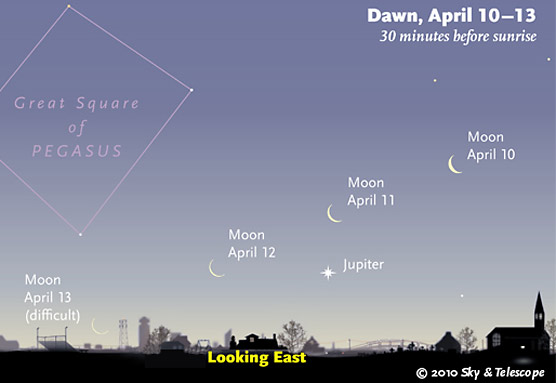
The waning crescent Moon passes Jupiter low in the dawn for early risers or very late night owls. (These scenes are always drawn for the middle of North America. European observers: move each Moon symbol a quarter of the way toward the one for the previous date. In the Far East, move it halfway.)
Sky & Telescope diagram
Sunday, April 11
Monday, April 12
Tuesday, April 13
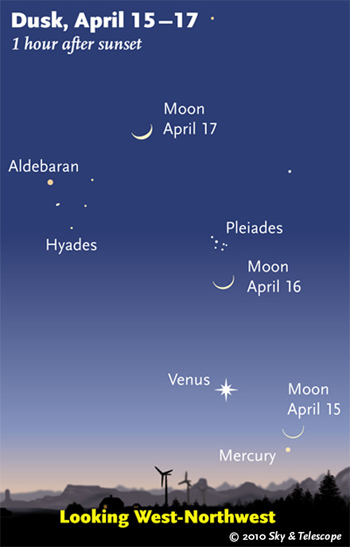
Use the crescent Moon and Venus to locate Mercury, terribly faded now and sinking fast. Binoculars will help.
S&T
Wednesday, April 14
Thursday, April 15
Later, as Mercury and the Moon set and night comes on, the huge, tall, tilted pyramid of the zodiacal light will come into view — if you're far from light pollution.
Friday, April 16
Saturday, April 17
Want to become a better amateur astronomer? Learn your way around the constellations. They're the key to locating everything fainter and deeper to hunt with binoculars or a telescope.
Sky Atlas 2000.0 (the color Deluxe Edition is shown here) plots 81,312 stars to magnitude 8.5. That includes most of the stars that you can see in a good finderscope, and typically one or two stars that will fall within a 50× telescope's field of view wherever you point. About 2,700 deep-sky objects to hunt are plotted among the stars.
Alan MacRobert
For an easy-to-use constellation guide covering the whole evening sky, use the big monthly map in the center of each issue of Sky & Telescope, the essential magazine of astronomy. Or download our free Getting Started in Astronomy booklet (which only has bimonthly maps).
Once you get a telescope, to put it to good use you'll need a detailed, large-scale sky atlas (set of charts; the standards are Sky Atlas 2000.0 or the smaller Pocket Sky Atlas) and good deep-sky guidebooks (such as Sky Atlas 2000.0 Companion by Strong and Sinnott, the more detailed and descriptive Night Sky Observer's Guide by Kepple and Sanner, or the classic Burnham's Celestial Handbook). Read how to use them effectively.
Can a computerized telescope take their place? I don't think so — not for beginners, anyway (and especially not on mounts that are less than top-quality mechanically). As Terence Dickinson and Alan Dyer say in their Backyard Astronomer's Guide, "A full appreciation of the universe cannot come without developing the skills to find things in the sky and understanding how the sky works. This knowledge comes only by spending time under the stars with star maps in hand."
This Week's Planet Roundup
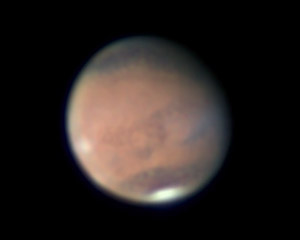
Mars was 9.0 arcseconds wide, and near the zenith, on the evening of April 2nd when S&T's Sean Walker took this image. The North Polar Cap (bottom) is diminishing in the northern-hemisphere spring. Walker writes, "The bright cloud on the edge of Mars was almost as bright visually as the polar cap!" He used a DMK camera on a Celestron 14-inch Schmidt-Cassegrain scope.
S&T: Sean Walker
Mercury and Venus are still together in the west-northwest during twilight, but Mercury is fading fast as it drops away from bright Venus. Look for it to Venus's lower right, farther every day. Venus is magnitude –3.9. Mercury is magnitude +0.1 on April 9th, +0.5 on the 11th, +0.9 on the 13th, +1.4 on the 15th, and +2.0 on the 17th.
Have you ever viewed Mercury as a tiny crescent in a telescope? Now's the time to try; see chart. The best views come long before sunset. See the April Sky & Telescope, page 53, for more on observing this tricky planet telescopically.
Mars, dimming into the distance at magnitude +0.4, shines very high in the southwest during evening. It's in Cancer, left of Pollux and Castor and above Procyon. With binoculars, watch Mars closing in on the Beehive Star Cluster, M44. At the end of the week Mars passes just to the cluster's north.
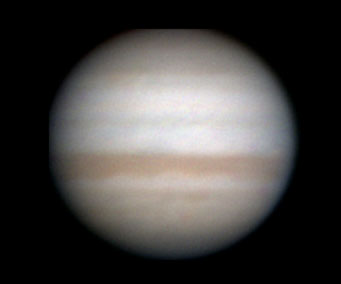
"My first [Jupiter] image this season!" writes Christopher Go from the Philippines. "Seeing wasn't great because Jupiter was only 23° above the horizon. I took this image less than 5 minutes before sunrise."
Note the extremely wide, dark red North Equatorial Belt, and the almost total absence of the South Equatorial Belt! Jupiter certainly looks different this season. In a small telescope, it's only one-belted. South is up.
In a telescope Mars is gibbous and shrinking: from 8.6 to 8.0 arcseconds in diameter this week. Can you still see its north polar cap, diminishing as the Sun rises higher on it in the Martian spring?
Jupiter (magnitude –2.1) is low in the glow of dawn. Look for it just above the eastern horizon about 40 minutes before your local sunrise time.
Saturn (magnitude +0.7, in the head of Virgo) is in the southeast after dark and shines highest in the south around 11 p.m. In a telescope Saturn's rings are tilted only 2.4° from edge-on. They'll narrow to 1.7° from mid-May through early June, then begin widening again.
Uranus and Neptune are hidden in the glow of sunrise.
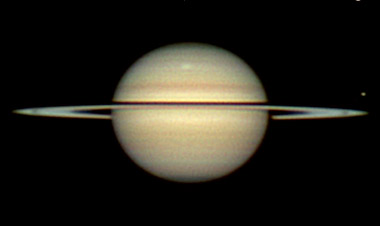
The Saturn Electrostatic Disturbance (SED) white spot is back! Christopher Go took this image on April 11th at 13:50 Universal Time, when the spot had just crossed the planet's central meridian. It's near System III longitude 15°. South is up. The satellite at right is Tethys.
Also note the dark reddish South Equatorial Belt, the bright Equatorial Zone, and the thin black line of the rings' shadow on the globe. The rings were tilted 2.5° to Earth's line of sight but 3.7° to the incoming sunlight. This disparity is what allows us to see the rings' shadow. It began in mid-March and will increase slightly in the next few weeks, making the shadow-line a little wider and more prominent.
http://saturn.cstoneind.com/
Pluto (magnitude 14, in northwestern Sagittarius) is highest in the south just before dawn.
All descriptions that relate to your horizon or zenith — including the words up, down, right, and left — are written for the world's mid-northern latitudes. Descriptions that also depend on longitude (mainly Moon positions) are for North America. Eastern Daylight Time (EDT) equals Universal Time (also known as UT, UTC, or GMT) minus 4 hours.
"Rational and innocent entertainment of the highest kind."
— John Mills, 19th century Scottish manufacturer and founder of Mills Observatory, on amateur astronomy.
To be sure to get the current Sky at a Glance, bookmark this URL:
http://SkyandTelescope.com/observing/ataglance?1=1
If pictures fail to load, refresh the page. If they still fail to load, change the 1 at the end of the URL to any other character and try again.
 0
0
Comments
You must be logged in to post a comment.